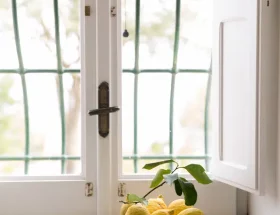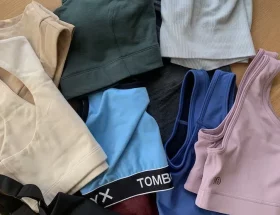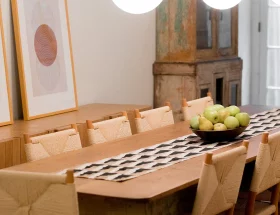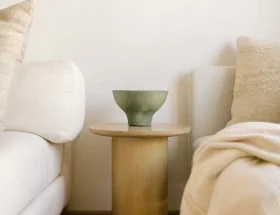Can Tech Help Us Slow Down?
“Dust collection, complete,” says a kindly but robotic voice in the corner of my apartment. Ole Dusty, my robot vacuum, has finished its morning duties.
“Whenever we talk about slow living, it’s easy to imagine a cottagecore paradise, self-sustained by solar panels and massive gardens.”
I’m sitting in the 7 a.m. sun, feet propped on my coffee table with a warm cup of coffee in my hand. My favorite playlist is playing softly on the speaker behind me, and the electric kettle in the kitchen is heating water for my oatmeal. I mixed blueberries, dried peanut butter, cinnamon, chia, and oats up earlier in the week, so all I have to do is scoop and pour. Things are automated, and things are—surprisingly—still slow.
Whenever we talk about slow living, it’s easy to imagine a cottagecore paradise, self-sustained by solar panels and massive gardens. We imagine rustic stovetop kettles and french presses, brooms and watering cans and cloth diapers for the children. What we don’t usually think of is asking an app to turn on the vacuum or setting the lights on a timer.
Recently, while I was in a state of overwhelm (and knee-deep in piles of laundry, both clean and dirty), I was asked a simple question that rocked my foundation: What if you asked for help?
I immediately balked; I don’t have children, I’m only caring for a one-bedroom apartment; I can’t possibly need help maintaining an already simplified life. But I desperately did.
I realized how much support I had needed as soon as Ole Dusty did its first cleaning. I was relieved beyond belief to finally have help with my biggest pain point: cleaning up after my house rabbits. They are the fluffiest, sweetest, and messiest creatures that require lots of maintenance (especially as they become increasingly geriatric).
But then, crucially, I had to decide what to do with the time I was saving. Would I empty and load the dishwasher? Start a load of laundry? Make the bed and tidy the bathroom? Write a book? Start a business? There’s always more to do, but this time—I decided to do less.
“There was less mess to remind me how far behind I had fallen, and only the sunrise on the horizon.”
Suddenly, my mornings looked like gazing out my apartment windows at passersby, crouching down to pet my rabbits in the early quietness of my day. I actually wanted to wake up earlier because I knew my cozy couch and my art journal were waiting for me. There was less mess to remind me how far behind I had fallen, and only the sunrise on the horizon. As I automated what I could, my evenings became slower too—longer dinners, more time spent gaming with my friends, and watching the sun go down from my porch.
So many of us need so much more support than we are getting, not because we need to complete more tasks in a day or because we must find new ways to stretch ourselves. Our to-do lists will always, always be fuller than our capacity. Instead, I think we all need more help so that we have more space in our schedules to revel in nothing.
Of course, slow living doesn’t require investing in robot vacuums (although if I ever become president, I will guarantee free robot vacuums for all). Automatic payments, email filters, timed coffee pots, regular reminders on our phones to drink water—these are all ways we can automate our lives without a large investment. When we convince ourselves that slow living is out of our reach because of our budget or because we live in a city, have kids, work online, and have a commute to work, we gatekeep ourselves from living in ways that suit us. We condemn ourselves to burnout because we don’t have a wilderness nearby to forage mushrooms or an old-timey alarm clock that sings us awake in the morning.
Automation is not the antithesis of slow living because slow living isn’t a state—it’s a mindset. Automatic processes, if they work for us personally, can support us in our journey to finding more peace and relaxation. “Digital minimalists see new technologies as tools to be used to support things they deeply value—not as sources of value themselves,” Cal Newport writes in his book Digital Minimalism. “[They are] interested in applying new technology in highly selective and intentional ways that yield big wins.”
Automation isn’t exactly the same as digital minimalism, but there are so many similarities, and I can’t help but appreciate Newport’s view on it. We can be selective about what we outsource and automate and decide what we need to do ourselves (for me: it’s my work, my relationships, and my self-care). If resources align and allow, we can use automation to help us with the other tasks and create more room for slow living in our lives.
“If resources align and allow, we can use automation to help us with the other tasks and create more room for slow living in our lives.”
But like I said, making our lives easier doesn’t always require investments. Here are some low- or no-cost ways to automate slow living:
- Create an automated routine you love and follow it every day. For me, I know when I wake up, I will listen to a news podcast followed by a curated playlist.
- Craft a Google spreadsheet that lists go-to meals and their ingredients for easier meal planning (here’s one on Etsy and a video walkthrough for those who want to nerd out).
- Add email filters to work and personal emails so that you only see the most important messages.
- Use a workspace to keep organized. I use Notion and call it my “Command Center,” ha!—it’s free and it helps me use technology for information storage rather than relying on my very tired and unreliable brain. Use your brain for thinking, and offload mental storage somewhere else, even if it’s a paper calendar.
- Use a budgeting app to track expenses.
- Set up auto-deliveries on things like toilet paper and rabbit litter.
- Honestly—and this one is small but significant if you work like I do—type docs.new into the URL bar to quickly create a new Google doc. I can’t begin to think how much time this tip has returned to me.
We all have pain points in our daily lives—and by paying close attention to where there’s tension in our schedules, we can begin to identify solutions to make things a little easier. We don’t have to be so hard on ourselves. And if solutions are difficult to come by, we can use other digital tools like Pinterest and Reddit to find out how others have solved similar problems.
Finally, I must acknowledge a huge drawback to automating slow living: automation breaks, systems go down, and schedules are interrupted. As I write, Ole Dusty sits dormant in its corner; the suction is malfunctioning, and it has gathered no dust in days. A support ticket has been submitted, and we’re waiting on repairs. But it’s a good reminder that automatic things won’t always exist, so we can’t grow idle and take them for granted.
“Slow living isn’t about how automatic or manual our lives are—it’s about being adaptable, prioritizing rest over busyness, and being open to possibilities.”
Slow living isn’t about how automatic or manual our lives are—it’s about being adaptable, prioritizing rest over busyness, and being open to possibilities, even if those possibilities mean our vacuums break, or our internet service goes down. Slow living is about offering ourselves a little more space to just be, and it can look however you want it to look.
When you think about it on a larger scope, finding new and innovative ways to support our slower lives actually returns us—yes—to “the good ole days.” We’re reaching back out to our communities (and now to our technologies) to help us maintain our homes, care for our families, and nourish ourselves once again.
So, no, we can’t order a slower life on auto-ship, but we can be open to the tools that deliver us peace—even if they’re automatic.
















